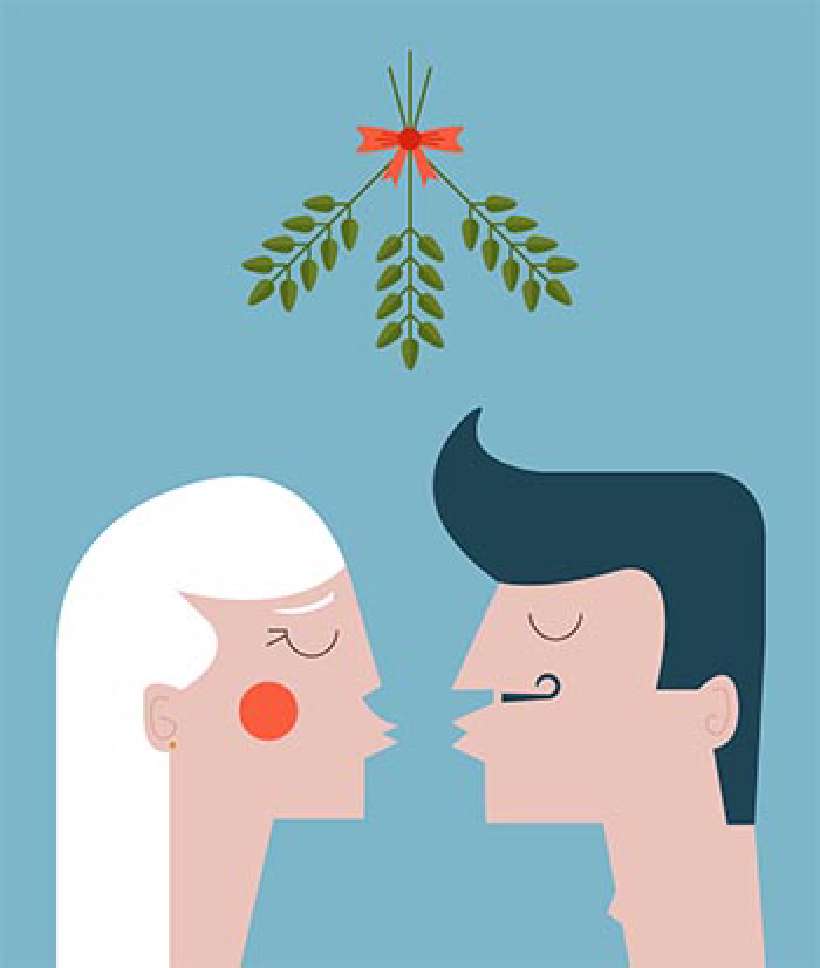Why do People Kiss Under the Mistletoe?
Home / Science for Kids / 5Ws & H For Kids / Why do People Kiss Under the Mistletoe?
In millions of homes in Europe and America, a sprig of mistletoe with berries is hung outside the doorway at Christmastime. According to custom, a man is allowed to kiss a girl if she is standing under the mistletoe.

Legend has it that when Balder, the son of the Norse goddess Frigga was killed by an arrow made of mistletoe by Loki, an evil spirit, Frigga wept tears of white berries which brought him back to life. Overjoyed, Frigga blessed the plant and bestowed to kiss all who passed beneath it.
From earliest times the mistletoe was regarded as a plant that increases life and fertility. However the Mistletoe themselves are are parasitic plants — they survive by attaching to the branches of a tree or shrub and absorbing water and nutrients from the host plant.
The mistletoe is actually a parasitic plant. It can only grow if its seeds are left on branches or tree trunks. When the seeds sprout it sends a single root that ends up as a sucker (or sucking mechanism). It enters the host tree, mostly oak, and eventually may surround an entire branch.
Birds eat mistletoe berries and the seeds stick to their beaks. When the birds rub their beaks the seeds fall on to other trees and the mistletoe sprouts again.
The mistletoe was considered magical by the Celts, who lived hundreds of years ago in what is now Great Britain and France. The Celtic tribes (Britons, Gauls, Irish, Scots, etc) were nature worshippers. They worshipped over 300 gods and their priests were called druids.
Many of their rituals were connected with the worship of trees and they believed that anything that that grew without its roots in the soil was mystical. They believed that the mistletoe was a gift from the gods for life and fertility and also guard against evil spirits. In the Celtic language mistletoe means ‘all-heal’.

Since the druids considered the oak tree sacred, they would cut the mistletoe that grew on it with a golden sickle (remember Asterix comics and the druid Getafix?) and hang it over their doors. They believed that this would bring happiness to whoever enters the house and would protect the family from evil spirits.
In ancient times it was customary for the visitor to kiss the hand of the host, signifying that the visitor has come in good faith. Since the mistletoe brings happiness, to kiss under it was a pledge of eternal friendship.
Custom has it that a man who kisses a woman under the mistletoe would pluck a berry, until all the berries are plucked. When there are no berries left, the kissing should cease.
Traditionally, if an unmarried girl is kissed under the mistletoe, the mistletoe is then burnt in the belief that the girl would get married.
When the Romans conquered Britain and Gaul (now France), they brought with them new rituals and adopted some Celtic ones. With the spread of the new Christian religion throughout Europe and Britain came newer rituals but this did not make people forget their early customs.
Hey, now, hold on! That doesn’t mean you lurk outside doorways waiting for just such an opportunity! Nor can you hold up a sprig of mistletoe over a girl’s head and kiss her. Instead of a buss on the cheek, you will probably get a sock on the mouth. So be(a)ware.
578 words |
5 minutes
Readability:
Grade 7 (12-13 year old children)
Based on Flesch–Kincaid readability scores
Filed under: 5ws and h
Tags: #europe, #seeds, #great britain, #celtic, #rituals, #mistletoe, #parasitic
You may also be interested in these:
Can Plants be Parasites?
The World's Hottest Chili
Shopping for Buyers
What Kind of Horses did Knights Ride?
The Bittersweet Story of Chocolate